Dream Jobs: Horse Photographer in the English Countryside
by Karen Braschayko
Sharon Malone spends her days in fields, woodlands and stables photographing gorgeous horses and the people who love them. Here she tells us how she and partner Andy Hopkinson created their equine photography business, The Horse Photographers, in North Yorkshire, England. She also shares touching stories about her work and offers tips for aspiring horse photographers.
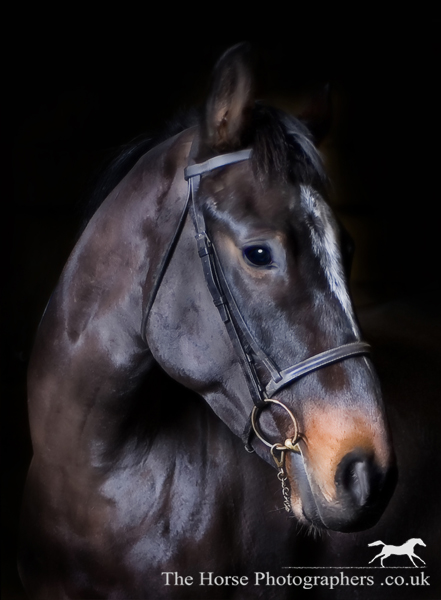
Karen Braschayko for Equitrekking: What is your background with horses? How did it lead to photographing horses professionally?
Sharon Malone: It’s a cliché, but I was virtually born in the saddle. My father is a horseman, as was his father before him and his mother’s family also, so I guess you can say it’s in the blood. Our family has always worked with horses in one way or another. I was raised on a working dairy farm that always had a number of horses. My first recollection of my own pony was coming downstairs one Christmas day morning to see what Santa had left. There, tied to the stair rail of the huge 17th century farmhouse, was a piebald Shetland pony we called Champion!
When I married, my husband was in the Royal Air Force. That meant moving around, and for a time in my life I was without horses. It felt like there was something missing. Both of my children, when young, had a keen interest, so I used to take them every week to riding lessons. Little did I realize that feeding my daughter’s interest in horses as much as I could would later lead me to a career change — to photographing horses.
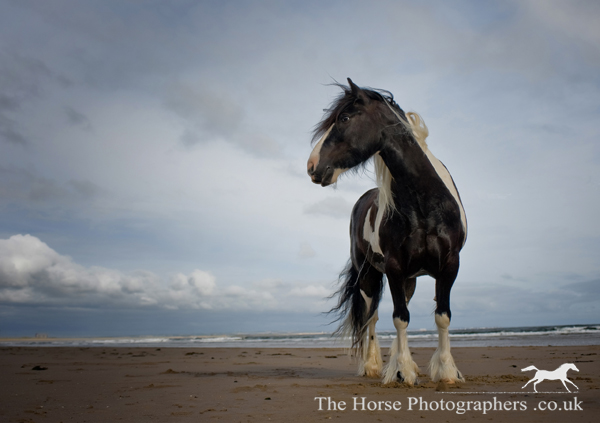
Sadly, my marriage broke down, and for a long time I was on my own with the children. With limited finances, the only luxury I managed was for them to continue their riding lessons. When birthdays came around and her friends were having girlie makeover parties, I would ask Natalie what she would like to do, and she would say, “Mum, can we hire some horses and go riding together?”
When she left home, one of the first things she did was to buy her own horse, but she picked totally the wrong horse. She knew this, but she bought him because she couldn’t bear to leave him where he was. He was a young Irish Cob colt. He wasn’t being treated very well, and his condition was awful, with overgrown feet and a coat full of lice. Plus, he had a mistrust of humans due to how he had been treated. He was very much a project horse.
Whilst looking for the kindest methods of working with Frankie, Natalie’s horse, I joined Intelligent Horsemanship in the UK. They advocate working with horses gently using the principles taught by internationally renowned trainer Monty Roberts. I took Natalie and Andy, my partner in the business and main photographer, along to see a Monty Roberts demonstration. Ironically, it was at Aintree Racecourse, the home of the Grand National, arguably one of the toughest horse races in the UK. We were all totally enthralled by what we saw, and I knew I wanted to do more in my life to use these principles with horses.
Andy has taught me everything I know about photography. We owned a very successful wedding and portrait business. In fact, we are recognized as one of the top 5 UK wedding photographers, not in any small part because of the special lighting effects we use with our couples. We use what we call a “Wedding Art” photo shoot on their wedding day. For family portraits, Andy was recognized as being the top photographer in the North of England. His images evoke emotion. Whilst the trend was to photograph on white backgrounds, high key and in color, Andy favored low key, dark backgrounds and monochrome. He rapidly became an expert in creative lighting. We didn’t know it at the time, but this was to be a key element of our equestrian photography, which separates us from any other photographer.
Natalie asked me to take some photographs of Frankie for Equine Rescue and Rehoming, a charity she had joined, as they were looking for a complete makeover of all their promotional material and website. Using my horsemanship skills and Andy’s creative lighting skills, we photographed Frankie in a unique style with Natalie. The charity used the photographs, and almost overnight we were inundated with requests to photograph other horses in the same way. Our new business, The Horse Photographers, was born.
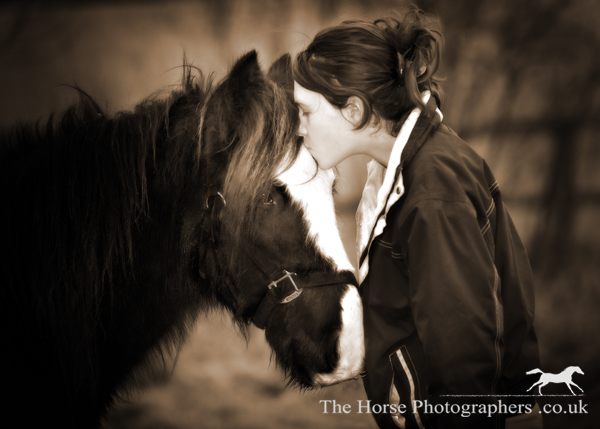
Frankie and Natalie in the photo that launched The Horse Photographers.
Equitrekking: What is your favorite aspect of photographing horses?
Sharon Malone: That is a difficult one, because for me it’s equally split between working with horses, which I absolutely love, and being able to be out in the countryside. I love starting with what is in effect a blank canvas and creating something really special. “Seeing” the picture and being able to translate that to something Andy can “read” from me, since it’s usually him behind the camera and me working with the horse and owner, is also really special.
Equitrekking: Do you have a favorite photo that you've taken?
Sharon Malone: Would it be totally biased to say the one of Natalie and Frankie that started off the business? Close second would have to be the photo of the little boy sitting on the ground with his miniature pony, where he’s kissing the pony. That to me just says everything about how we should bring up our kids around horses and ponies. He was confident and at ease around his pony, but he also treated him with total respect and love. When the miniature sat down on the ground, little Harry went and sat next to him. The pony reached out to Harry, and he responded. We captured every move as it happened.
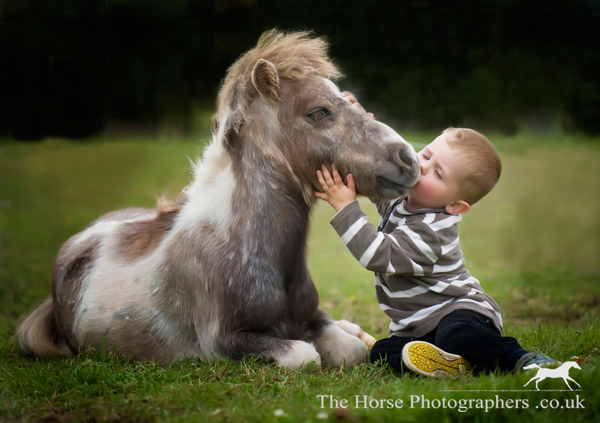
Equitrekking: What are the biggest perks of the job?
Sharon Malone: Overall the biggest perk, I think, is getting to meet all the different horses and people from day to day, forming lasting friendships with them, and being able to work in such a fantastic environment. I do spend a considerable amount of my time working on the computer, writing for a couple of magazines and blog posts, assisting Andy in editing the photos, and keeping in touch with our clients and fans via social media such as Facebook, but I would hate to have a job which meant I had to work indoors all the time.
Equitrekking: What is a typical day like for you, if there is such a thing? What might a photo shoot involve?
Sharon Malone: No two days or creative portraits are ever the same. They can’t be because of not only the individual people involved but also the different horses. Some horses are really inquisitive and want to see what we are doing, while others are a little wary and we need to build their trust. We also try to incorporate into our portraits the story behind the photo shoot. There always is a story behind each and every portrait we undertake. Sometimes it’s centered around the relationship between the equine and the owner, or sometimes it’s focused on the family we are photographing. Discovering the story and then reflecting that in the photography is perhaps the most challenging aspect.
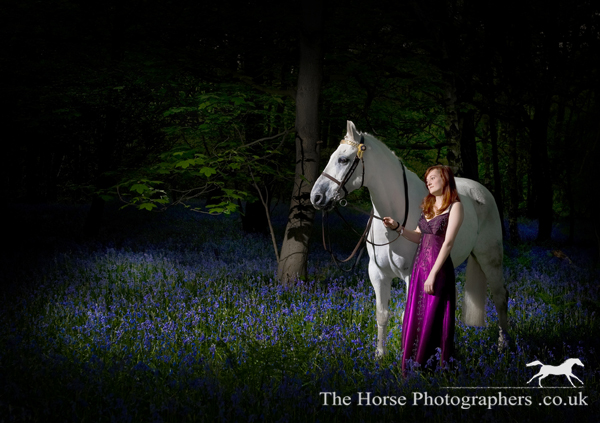
Before the photo shoot, I will have chatted with the horse’s owner about what sort of thing they may want from their photos, and I make suggestions as to what we might do. Most often those suggestions are taken on board, and we create something really special and different than anything they ever imagined when they originally commissioned us.
Armed with the information I have gathered, we go along to the photo shoot with perhaps the seed of an idea as to what we might do. Then we get to meet the horses! This is my favorite part of the entire photo shoot – working with the horses. Because we use a variety of different creative lighting equipment, we need to know that the equine will be accepting and safe around the flashes. We use special techniques we have learned to desensitize the horses and let them gradually get used to artificial flash lighting. Usually they are very accepting, but occasionally it takes a little time. Of paramount importance is the comfort and safety of the horse, the owner and, of course, us.
Depending on how structured the photo shoot is that we’ve planned, we will then photograph a variety of looks and different poses of both horse and owner. We very much go with the flow on most photo shoots, but there are some key shots we always take, such as the horse’s eye. That is historical to me, as whilst I was being raised by my dad, over and over again he would tell me to look for a kind eye in a horse. I still do that to this day.
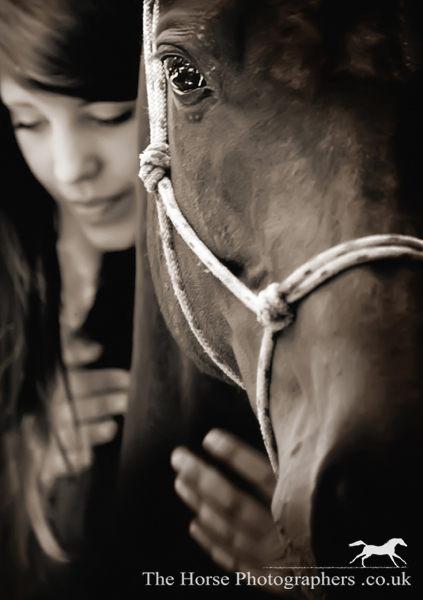
Equitrekking: What kind of working conditions can a horse photographer expect?
Sharon Malone: I think the first word that springs to mind is muddy. Often our conditions underfoot are damp and muddy here in the UK. This is quickly followed by cold and lack of restroom facilities!
Equitrekking: What are some challenges of working as an equine photographer?
Sharon Malone: Sometimes it is a challenge staying safe if we have a young, unpredictable horse. Other times the challenge is reaching some remote locations with our equipment, even though we drive a 4x4.
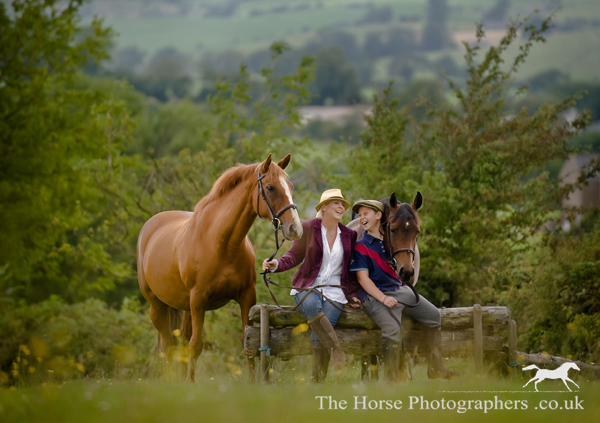
Equitrekking: What tips would you give someone seeking a career as an equine photographer?
Sharon Malone: I believe that to photograph horses the way we do, it requires two people – a photographer and a horseman. The photographer needs to be able to use the camera intuitively, since you also need to be aware of what the horse is doing. The horseman needs to know how to work with horses, enabling them to be relaxed and with ears pricked in the direction you want them to be. They also need to understand the psychology of horses and how to read them in order to gain a bond quickly and effectively.
Work hard! First and foremost, photography can be taught, but great horsemanship can’t, in my humble opinion. It’s instinctive and intuitive, and along with that intuition comes an understanding of what others with a similar passion for horses might love to see in a photo. Study the behavior of horses. I can tell an awful lot from the twitch of an ear or the way a horse is standing. You need that understanding if you are going to work in close proximity with equines while photographing them.
.jpg)
Equitrekking: Do you have any interesting stories about photographing horses?
Sharon Malone: We have photographed some amazing people. Every portrait tells a story, but three stand out.
We photographed a lady with her two horses and child in the beautiful countryside overlooking the Yorkshire Mills. They sat on a cross country jump because the child, although she has a passion for horses, cannot ride. She has brittle bone disease, and movement of the horse would mean her bones could shatter. The stables where her horses are kept specialize in Riding for the Disabled (RDA), and they are now applying for a horse and cart driving license from RDA. With approval from her orthopedic surgeons, this girl is training to be chief whip, which means she will work with the horses she loves.
Another is a family who had a pony with one eye, a dog and three children. They have a child with Down’s syndrome, and they thought we might not be able to photograph him well due to his challenging behavior. We designed a Pocahontas-style, Native American themed photo shoot with them, complete with a wigwam, and the little boy loved it. All the family cried when they saw the photos.
The lady who moved me most of all, however, was a retired veterinary surgeon. She stood less than five feet in height. All her life her passion had been breeding and showing Dutch Warmblood horses. The horse we were to photograph, called Mousse, stood 17.2 hands and represented the pinnacle of her breeding career. When we arrived, Mousse was listening to classical music in her stall. Her mane and tail were plaited to perfection, and her rump had crisscross hairs brushed as if she were about to go into the show ring.
Her owner wanted her photographed as if to show and as if she were about to ride her. She changed her outfit from a bowler hat for the show look to a classical English tweed jacket, jodhpurs and peaked riding hat for the riding photos. When we needed to change the noseband on Mousse from her cavesson to a flat one, her owner had to stand on an upturned milk crate in order to reach. I had to assist her to do the fastener, as her fingers were so gnarled and twisted by arthritis that she couldn’t use them. I wondered how she had plaited her mane and tail so neatly. She had been up since 4 a.m. getting Mousse ready, she said, and through all of it stood on the milk crate, though she could hardly walk due to her arthritis. We were humbled by her that day.
See more of Sharon and Andy’s work at www.thehorsephotographers.co.uk, and watch videos on their YouTube channel.
Karen Braschayko is a freelance writer and horse lover who lives in Michigan.




